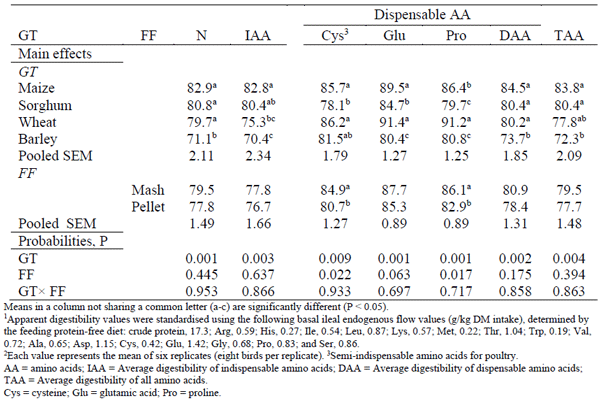I. INTRODUCTION
Knowledge on the digestibility of amino acids (AA) in raw materials is crucial for precise feed formulation, and for more efficient and sustainable use of feed resources. The accuracy of excreta-based digestibility measurements for determining N and AA digestibility may be questionable, due to the variable effects of the caecal microflora on dietary protein utilisation and the contribution of microbial proteins to AA excretion in the excreta of birds. In the ileal digestibility assay these confounding issues are avoided. Ileal AA digestibility values can be referred to as either apparent or standardised/true. Standardised ileal digestibility (SID) involves a correction for the inevitable endogenous AA losses from the gastrointestinal tract (Lemme et al., 2004), and SID values are more additive than the apparent values. Application of SID AA in practical feed formulation would benefit poultry production by improving the accuracy of feed formulation, and reducing diet costs and nitrogen pollution (Cowieson et al., 2019).
A large volume of published data (Ravindran et al., 1998; Lemme et al., 2004; Bryden et al., 2009) on AA digestibility of a range of feed ingredients for broilers is now available. These available values of digestible AA for broilers have been determined using mash diets, due to simplicity. However, the majority of feed used in broiler production is fed in pelleted or crumbled forms, and feed processing, texture and conditions associated with the pelleting process, such as temperature and moisture, have a substantial impact on nutrient digestion
(Abdollahi et al., 2013a). Furthermore, it has been speculated that hydrothermal treatment of feed may enhance protein digestibility due to denaturation and dissociation of protein macro-structure into smaller subunits (Camire, 1991; Ludikhuyse et al., 2003). On the other hand, steam-pelleting of diets might decrease the protein solubility that compromises its availability for the bird (Svihus and Zimonja, 2011). Recent evidence suggests that the nature of the digestibility response to the pelleting process is dependent on the ingredient and the specific nutrient (Abdollahi et al., 2013b). Therefore, the application of AA digestibility data generated with mash diets to practical situations, where feed is in pelleted form, could be questioned. Based on the above, it was hypothesised that broilers fed the same diet but in different feed forms (FF) may show different AA digestibility values. Consequently, the present study was designed to determine the influence of FF (mash vs pelleted) on the SID of nitrogen (N) and AA in different feed ingredients.
II. MATERIALS AND METHODS
The study was divided into two experiments. A completely randomised design in a 4 × 2 factorial arrangement was used in experiment 1, which included four grain types (GT; maize, sorghum, wheat and barley) and two FF (mash vs pelleted). The cereals were obtained from a commercial supplier and ground in a hammer mill to pass through a screen size of 3.0 mm. The eight assay diets contained 938 g/kg cereals as the only source of AA in the diet. Experiment 2 was designed in a 3 × 2 factorial arrangement including three protein sources (PS; meat and bone meal [MBM], soybean meal [SBM] and canola meal [CM]) in mash and pelleted forms. A N-free diet (NFD) was also used to determine the basal endogenous N and AA losses for the calculation of SID values. Titanium dioxide (TiO2; 5 g/kg; Merck KGaA, Darmstadt, Germany) was added to all diets as an indigestible marker. The pelleted assay diets were steam-conditioned at 70 ºC for 30 seconds and pelleted using a pellet mill (Richard Size Limited Engineers, Orbit 15, Kingston-upon-Hull, UK) equipped with a die ring (3-mm holes and 35-mm thickness). Each of the diets was offered ad libitum to six replicate cages (eight birds per cage) from d 19 to 23. On day 23, all birds per cage were euthanised by intravenous injection of sodium pentobarbitone solution and digesta were collected from the distal ileum, pooled within a cage and used for determination of SID of N and AA.
III. RESULTS AND DISCUSSION
The influence of GT and FF on the SID of N and AA are shown in Table 1. There was no GT X FF interaction for the SID of N and AA. The main effect of GT on the SID of N was statistically significant (P < 0.001), with lower digestibility in barley-based diets compared to any other grain. Maize-based diets showed similar (P > 0.05) average SID values for indispensable AA (IAA) to sorghum, but higher (P < 0.05) than wheat and barley. Average total amino acid (TAA) digestibility was higher in maize and sorghum compared to barley. The trends of higher AA digestibility in maize followed by sorghum, wheat and barley are in agreement with previous findings (Lemme et al., 2004; Szczurek, 2009). Feeding pelleted diets reduced (P < 0.05) the SID of cysteine and proline and tended (P = 0.063) to decrease the SID of glutamic acid. Cysteine is the most heat labile of all AA and its digestibility is affected during hydrothermal treatment (Abdollahi et al., 2013a), most probably due to the formation of disulphide bonds (Wall, 1971).
Table 1 - Influence of grain type (GT) and feed form (FF) on the standardised ileal digestibility1 (%) of nitrogen (N) and amino acids2 (experiment 1).

The influence of PS and FF on the SID of N and AA are shown in Table 2. There were no significant interactions between PS and FF observed for the SID of N and AA. The SID of N was significantly (P < 0.05) higher in SBM than all other protein sources, and higher in MBM compared to CM. Average SID of total AA were similar in SBM and MBM, and higher than that in CM. Lemme et al. (2004) previously reported higher SID of protein in SBM (90%) than CM (76%) and MBM (65%) in broilers. Histidine was the only IAA significantly (P < 0.05) influenced by FF; it was reduced by pelleting. Pelleting, however, resulted in a significant reduction in the SID of all individual DAA, average SID of DAA and TAA. As suggested by Goodarzi Boroojeni et al. (2016), the possible effect of hydrothermal treatment on protein denaturation is not necessarily associated with higher protein or AA digestibility. Overconsumption and overload of nutrients in birds fed pelleted diets have been shown to reduce the digestibility of major nutrients (Abdollahi et al., 2013b, 2018). Also, Engberg et al. (2002) observed smaller gizzard and pancreas and lower amylase, lipase, trypsin and chymotrypsin activities in pellet-fed birds than those fed mash feed. Therefore, the lower SID of AA in pelleted diets in the present study might be partly explained by reduced activity of proteolytic enzymes in the digestive tract. In addition, the lower digestive organ weights (relative to feed intake) induced by feeding pelleted diets, might shorten digesta retention time, compromising digestion and absorption of nutrients (Abdollahi et al., 2018). Overall, the current study suggests that FF can influence the measurement of AA digestibility, in particular dispensable AA, in protein sources and, therefore, should be considered in future AA digestibility assays.
Table 2 - Influence of protein source (PS) and feed form (FF) on the standardised ileal digestibility1 (%) of nitrogen (N) and amino acids2 (experiment 2).
Presented at the 30th Annual Australian Poultry Science Symposium 2020. For information on the next edition, click here. 







